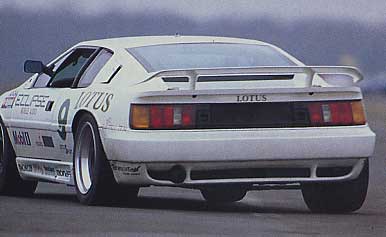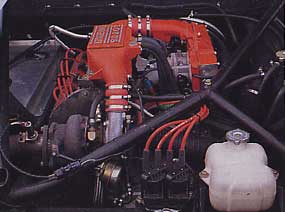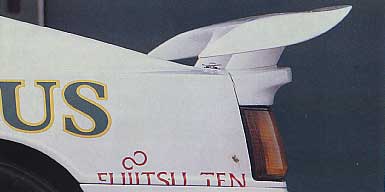

Esprit of America
When Lotus was invited to race the cream
of Corvettes on its home patch,
the result was an Esprit
to covet.
Jeremy Walton was our man in the 170mph cockpit.
There is no more windsept section of wintry Britain than East Anglia. As I watched members of the Lotus Engineering squad wave my charge away, the warm glow of smug self-satisfaction was a cosy as the single-seat cockpit of the very special Esprit I was driving.
Nicknamed the "Film Star Car" this 300 plus horsepower racing Esprit was on of five such mid-engined models that the Norfolk factory had constructed to tackle the competition Corvettes on the circuits of America. The star appellation came from the occasional presence of Paul "turn that in-car camera off" Newman, but my mount for the day had been driven by Bobby Carradine regularly to take second overall in the Sports Car Club of America Escort World Challenge Series.
Lotus has raced 17 times in America, winning four times in 1990 and the same in 1991, when they tackled both SCCA and International Motor Sports Association events, creditably finishing as runners-up in the overall SCCA Championship title hunt in both years.
The 1991 version was a much improved vehicle, drawing not just on 1990 racing Esprit experience, but also a wider range of parts permitted by the marketing of 20 street legal replicas (dubbed X180-R) that were sold for $126,000 apiece (approximately £70,000). A trio of new racing Esprits was created by Lotus Engineering for 1991, and it was just such a rapid Esprit that we drove.

It was tended at Hethel by John Miles, former TWR employee Colin Marriott and powertrain expert Alan Nobbs. Some two years of competition development have prompted an Esprit that is stronger, lighter and fleeter, but the really pleasing factor is that all such work has been so firmly production based.
Even that unfamiliar deep front spoiler drew inspiration from the now defunct Excel, whilst the rear wing is a repositioned redefinition of the showroom SE item. The circuit chassis development promises unprecedented feedback for customers. Feedback for the racing Esprit driver is phenomenal.
Our abiding memory from a typical airfield track full of bumps and damp sectors, will be of the steering. It is so informative that every change of surface and camber chatters back through the leather Momo steering wheel trim. Delivering a constant stream of useful data the Reuters would be hard pushed to match.
The unassisted rack and pinion remains at the standard ratio, but is more rigidly mounted to perfectly complement a substantially (plus 20% in torsional stiffness) stronger chassis and strategically beefier suspension. Much of the torsional improvement can be traced to the Lotus designed Safety Devices steel roll cage that twines its way from the cabin to pick up some of the incoming front and rear loads.
This competition car is comparatively softly sprung and damped ("using much the same spring frequencies as Formula Ford", states Miles). Traction is given maximum attention and no rear anti-roll bar is allowed to compromise the ability of the monstrous Corvette specification Goodyears (Bridgestone for IMSA events) to transmit horsepower under duress. A ZF limited slip differential is set to bite softly. The complete ensemble — with solid rose joints for the rear end components — works brilliantly.
The 2.1 mile Lotus track is comprised mainly of swift (fourth gear) swerves, but the slowest (second gear) corner was not only damp throughout the apex, but also delivers you straight toward a narrow exit with sturdy wall. If this is not enough to test man and machine, the bumpy third and fourth gear sector that follows examines ride quality with Belgian backroad thoroughness. It then serves up a fourth gear left with the apex apparently buried in a clipped hedge!
Ride and stability (under braking, or power) over said bumps was astonishing. In the faster corners some of the massive grip comes courtesy of the replacement aerodynamics aids, for they manage to generate 220lb of downforce at the calculated 170mph maximum. All whilst preserving a reasonably slippy 0.345 Cd.
Whilst retaining "90% production parts," the turbocharged 16-valve has been gradually uprated. This from a showroom 264bhp to 285bhp in 1990 and at least 300bhp in 1991. The company identified the sources of such durable motivation as: oversize fuel injectors, enhanced chargecooling, replacement non-catalyst exhaust system and reprogrammed ex-GM Electronic Control Unit hardware. Lotus Engineering dialled a regular maximum of 1 bar (14.5psi) boost, rather than a usual 0.85bar (12.3psi) overboost.
On the wintry test day, boost beyond 1 bar flicked up in fourth at a constant 7,400rpm. I believe that at least 330bhp accompanied the exceptionally generous torque and power curves. The unit was asked to provide serious grunt anywhere from 3,000 to 7,800rpm.

That brings us neatly to the Achilles' Heel of the racing Esprit: clutch and gearbox. The ample availability of boost, and therefore pulling power, from 3,000rpm in third, is vital. The Renault Alpine R25 transaxle does not have synchromesh capacity to spare for racing shifts. So you restrict the number of changes, utilising that engine flexibility, trying to preserve the gearbox.
A standard clutch dislikes racing and is changed after every event. "Ours" also had a fault in the release bearing operation so that we were plagued by an unusual degree of clutch slip in fourth and fifth.
Despite those snags, acceleration was a strong feature. FAST LANE recorded a 1991 test SE road car from rest to 60mph in 4.6sec, zipping on to 100mph in less than 12sec. Thus a 300lb lighter racer, with at least another 36bhp, was bound to be impressive.
The exhilaration of bounding the track Esprit from corner-to-corner was countermanded by truly fabulous brakes, overcoming a traditional weak point of the road car. AP racing four-piston calipers and ex-Lotus Carlton disc diameters, which are larger than Mini road wheels, transformed Esprit retardation.
You flit past a 200 yard marker board at the end of the main straight in excess of 120mph. The pads kiss vented discs. It feels as if you have run into a chocolate mousse. The Esprit simply loses all that momentum, you have time to mollycoddle the gearchange and dial up some boost, ready for the next apex.
The Esprit was not the smartest works car I have driven, but it had the most grip on special road tyres (albeit, very special road tyres of near slick tread moulding) that I have experienced. The faster the corner, the better behaved it was. Even a stranger could happily bodge around damp second gear deviations, and have a bit of a skid, without slipping over the friendly borders of its immense handling capabilities.
Editor English wanted to know how the company had "cut that bloody understeer in the Esprit?" Answering that racing query it was revealed that a number of moves are in hand that will improve the handling of the Esprit in its diminishing production life.
Our sources say that the production Esprit will be put back to a specification that includes no element of pro-dive in the front suspension. This will be done by moving one pick up on both front wishbones. Lotus also plans to insert polyurethane front bumpstop rubbers to act when the front end runs out of travel and promotes understeer.
We gather that the "big wing" Esprit — pending immediate production when called — will not have these chassis running changes. We could not ascertain when such changes would be made with any certainty, but the engineering production moment is awaited.
The racing Esprit had steering, brakes, acceleration and a sheer joy of driving that were magnificent. Such qualities deserve to be passed on to customers in the largest practical measures. All underline that Lotus knows more about going fast on limited horsepower than any other car company. Surely an even more relevant objective in the nineties than it was during the fifties' foundation of Lotus?

|
|